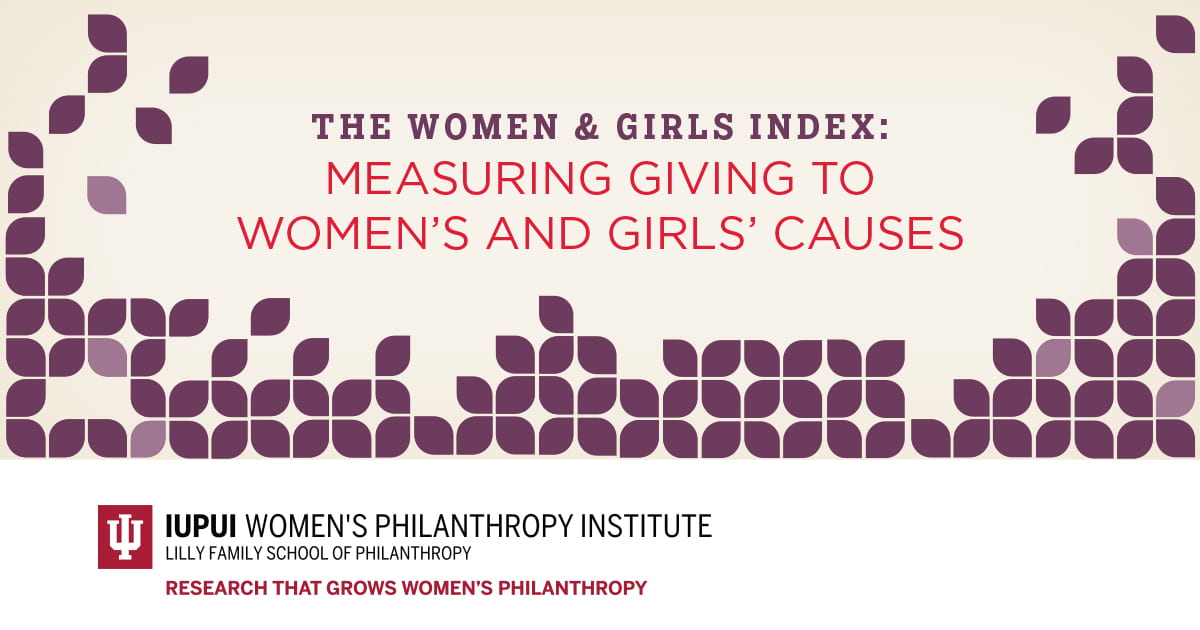
This week, the Women’s Philanthropy Institute (WPI) released the Women & Girls Index 2020: Measuring Giving to Women’s and Girls’ Causes—our second annual report on the Women & Girls Index (WGI). The WGI is the only systematically generated, comprehensive index of charitable organizations dedicated to women and girls in the United States.
The Index includes nearly 47,000 organizations—3.4 percent of all charitable organizations—that are either: dedicated to serving primarily women and girls (e.g., Planned Parenthood and Girls Inc.) or collectives of women and girls that serve general philanthropic purposes (e.g., Junior Leagues and women’s auxiliaries).
Why did WPI release a second report on the WGI? What is new about this year’s report?
Tessa Skidmore explains WPI’s newest report. |
The WGI reports use data from the Index to describe key characteristics of women’s and girls’ organizations, with a focus on the levels of philanthropic support they receive. The inaugural 2019 report provided a snapshot of this information for 2016, the most recent year for which finalized data on charitable organizations was available.
The 2020 report is based on an expanded version of the WGI, which adds historical data for 2012 through 2015, as well as updated data for 2017.
This expansion offers the first multi-year look at how philanthropic support for women’s and girls’ organizations has changed in recent years. The 2020 report also looks at government support for these organizations—a new data point that was not included in 2019—and features insight from interviews with four leaders of women’s and girls’ organizations.
What did the report find?
- Philanthropic support for organizations dedicated to women and girls increased by 36.4 percent—similar to the rate of growth in philanthropic support for other charitable organizations—from 2012 to 2017. Growth in philanthropic support for women’s and girls’ organizations was especially strong in 2017 (9.4 percent).
- While philanthropic support for women’s and girls’ organizations increased across the board from 2012 to 2017, particular types of organizations—such as those focused on reproductive health (85.2 percent) and family and gender-based violence (41.6 percent)—saw especially strong growth.
- Government grants to women’s and girls’ organizations increased by 34.4 percent from 2012 to 2017, significantly more than the 14.6 percent rate of growth in government grants to other charitable organizations. Other financial measures like revenue, assets, and expenses grew more slowly for women’s and girls’ organizations during this time.
- Philanthropic support for women’s and girls’ organizations reached $7.1 billion in 2017, but still represents a small share of overall charitable giving (1.6 percent).
- Although the composition of women’s and girls’ organizations based on nonprofit subsector and mission focus largely held steady in 2017, organizations dedicated to general and reproductive health received an increased share of philanthropic support.
The report focuses on data from 2012 to 2017. How can the findings be applied to research and practice in the present moment?

Leaders of the women’s and girls’ organizations interviewed for the report stressed the importance of funders exercising flexibility and trust in their grantmaking during the current crises and beyond.
The interviewees agreed that it is critical for funders to provide the ability for grantees to pivot to address present challenges. This includes offering more unrestricted funding that allows organizations to spend dollars as they see fit and loosening reporting requirements.
The women’s and girls’ organization leaders interviewed also emphasized the role of small gifts—at any time, but especially in the current environment. Tammy Tibbetts, CEO of She’s the First shared: “I have continued to be blown away by the generosity of everyday people and just how people who have so many other demands on their lives right now still are showing up for … girls around the world.” Interviewees also noted the value of engaging supporters in non-monetary activities to ingrain them more deeply into the organization’s mission.
Beyond informing the practice of philanthropy, the WGI makes a significant contribution to research on giving to women’s and girls’ causes. The updated Index includes multiple years of data, which provides a basis for examining trends over time.
The WGI allows scholars to apply a gender lens to existing studies and to explore new research topics. Individuals and organizations can access this publicly available resource and use it to answer their own questions in a variety of areas related to women’s and girls’ organizations.
Tessa Skidmore is a visiting research associate for the Women’s Philanthropy Institute.

Leave a Reply